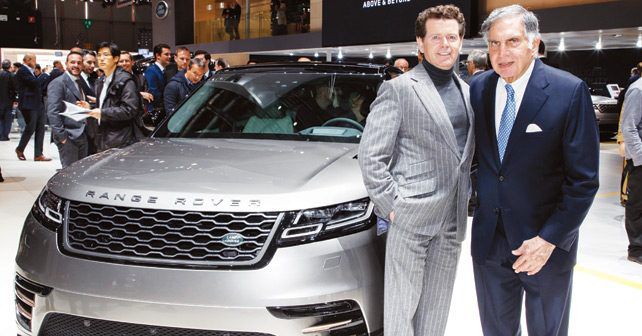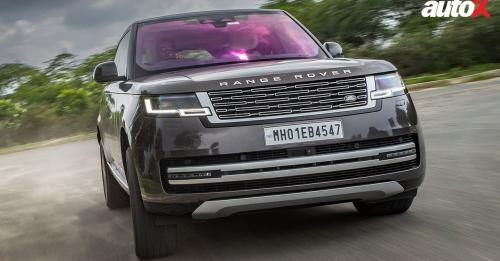
After the US unveil of the Range Rover Velar, we sat down with Land Rover’s Chief Design Officer, Gerry McGovern, to understand his vision and design direction for the future.
The Range Rover Velar almost looks as though it should have been the Range Rover Sport – was that intentional?
The Range Rover Sport is much bigger than the Velar, and deliberately sits higher. It’s a bigger package and is a slightly smaller brother of the bigger Range Rover. Clearly, the Velar sits between the Range Rover Sport and the Evoque. It’s moving the game on in terms of design. The Range Rover Sport was designed six years ago, and we’re working on the replacement for that. Interestingly, when Mr. Ratan Tata saw the very fist visual of this car, he loved it and was passionate about seeing it reach production. Together, Mr. Tata and I were pushing the idea of flush door handles. And this is the first iteration of that.
Will some of the design and technology of the Velar trickle down into other cars from your range?
You can still see that this is a Range Rover. It still connects to our existing range, except that it moves the game along. For example, the flush door handles – if I wanted to have them when we designed the Sport six years ago, we didn’t have the technology to achieve it. In the same way, the Matrix laser lighting on the front enabled the super slim lamps. With the Velar, we took a modernist approach to design and we’ve paid attention to ensure minimal switches in the interior to create a calm sanctuary. I’m not an advocate of what I call ‘desire and design.’ Some cars have 50 lines running across the body sides. For me, less is more.
The Tata Board, and Mr. Tata, have been prolific in terms of giving us the powerbase to help change the culture. Remember that Land Rover came from a very functional base, where design was more like an afterthought – and we’ve turned it the other way around. Now design takes the lead and creates the concept as well as the basic engineering of the vehicle.
Did the flush door handles come about primarily for design or for better aerodynamics?
Quite often, if you do things for the design the aerodynamics get the benefits too. We work very hard with our aerodynamicists to find ways of making the cars more aerodynamic without compromising on design. Frequently, aerodynamicists think things will improve by doing certain things, but they do the opposite – so it’s an intricate process. For me, the flush door handles make the sides of the vehicle much cleaner – and it also provides an aerodynamic benefit too.
How important is it for a Range Rover to stand out in an off-road environment?
It’s important, but it needs to be relevant. We respect our heritage, but we shouldn’t be harnessed by it. You see Range Rovers everywhere in big cities. The reality is a lot of people don’t take them off-road. However, they want that story – they want the comfort that they are capable of going off road if they have to. So, that will always be in our roots.
If people use these kinds of vehicles primarily in an urban environment, then why not do away with some of the off-road capability?
That’s like saying to a Swiss watch manufacturer to make the watch digital. We always want to be the best in class in all-terrain capability. I drove the new Discovery in Utah, and it’s an incredibly capable car. I remember when we launched that car in Paris, I said ‘don’t be fooled by this vehicle’s good looks, it’s just as capable – if not more so – than its predecessor and that’s a part of the charm of these things.
Sound is such an important factor in the appeal of many of your cars. With the absence of that in the upcoming generation of EVs, will design need to make more of an impact?
For me, design is the impact! In the mass car market, I think it’s more a case of the icing on the cake. But, for us, design is at the very core of everything we do. Design manifests itself in every way – it’s not just aesthetic, but also in the way it functions, as well as the way it’s designed in terms of versatility and durability. For me, what I call emotional design consists of three elements – visceral, behavioural and reflective. We’re not designing vehicles that just go from A to B anymore. We’re designing the dreams of people. People buy these things because they build relationships with them and they love them.
Do you relish the rivalry with Jaguar now that they’re also making SUVs?
I wouldn’t call them rivals, because they’re family. The beauty of the Jaguar-Land Rover relationship is that they are brands that are totally different in terms of their essence. If you accept the notion that design is what communicates what the brand represents, then clearly our DNA is totally different from Jaguar. If you look at the SUV market, which is now fragmenting, it’s growing massively. So I think there’s more than enough room for both of us if we’re clever about it in terms of economics and parts sharing, without it being obvious to the customer. I welcome the fact that Jaguar sells SUVs too. I don’t think they’ll do the numbers that we do, as this is our area of specialism. And they’re never going to be comparable in terms of the capabilities because that isn’t what they’re about. But I’d much rather competition came from Jaguar, rather than, say, Audi or Volkswagen.























Write your Comment